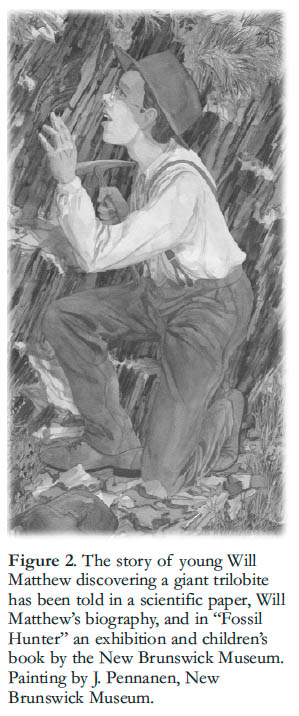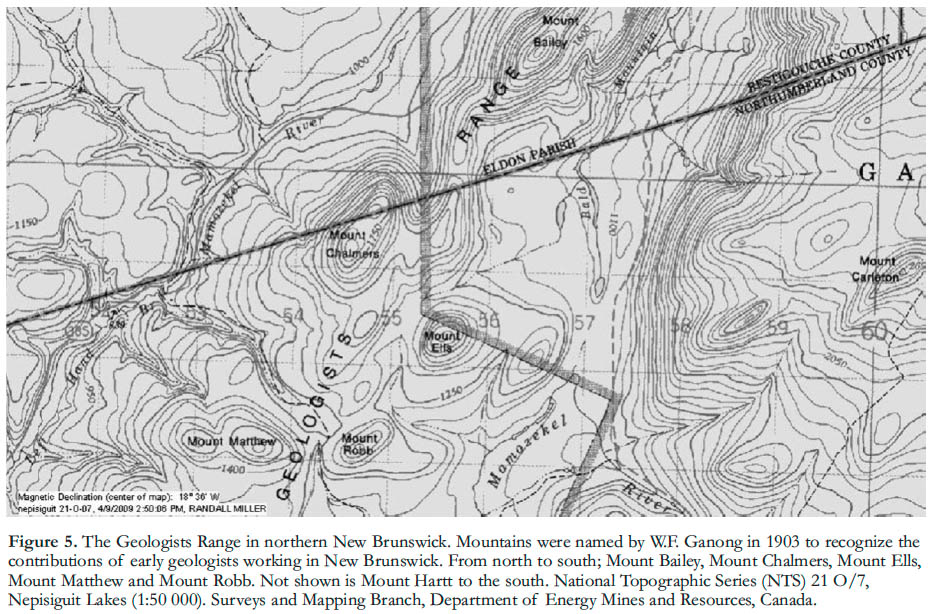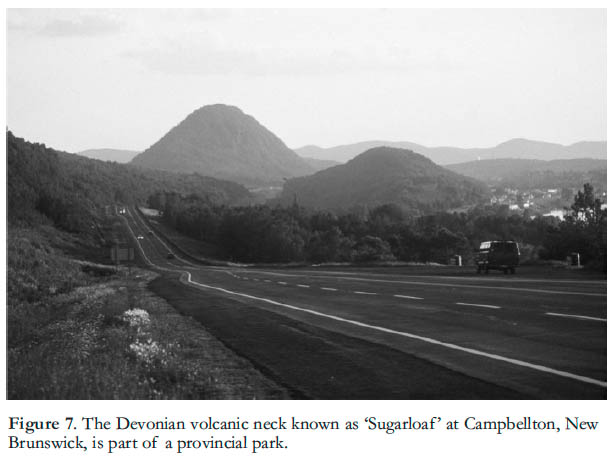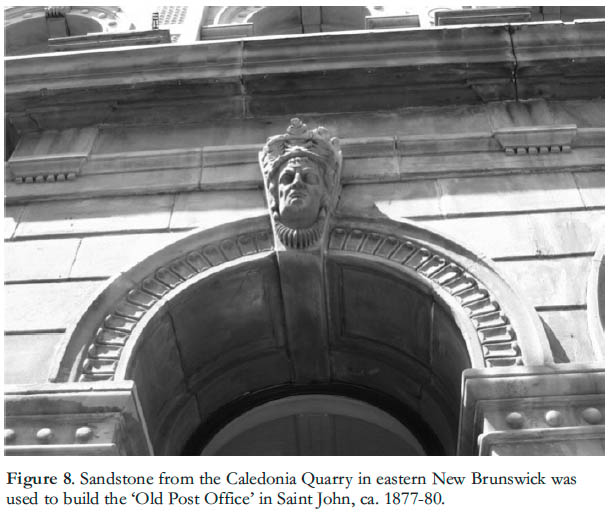Series
Geoheritage 5.
Geoscience Heritage in New Brunswick
Randall F. MillerSteinhammer Palaeontology Laboratory, Department of Natural Science, New Brunswick Museum, Saint John, NB, Canada, E2K 1E5
randall.miller@nbm-mnb.ca
SUMMARY
Geoheritage encompasses a broad range of topics, from the preservation of geological sites, to maintenance of archival and specimen collections, gathering and dissemination of data, legislation, and geotourism. New Brunswick has a long history of geological investigations that have considerably advanced our understanding of a complicated geological past spanning one billion years. Although the province contains a number of classic geological sites, and many of the first geological explorations in the country were conducted here, only two of more than 1100 historic sites in the province are based on geohistory. Fortunately, geoheritage resources are readily available in New Brunswick, and many of the early geosites are still accessible. Improving geoheritage in New Brunswick is, in part, the responsibility of members of the local geo-science community, which knows it best. Existing heritage systems, such as New Brunswick’s Register of Historic Places and the national Historic Places Initiative, provide the means to ensure that geoheritage becomes part of society’s collective heritage awareness.SOMMAIRE
La notion de patrimoine géologique recouvre une gamme variée de sujets d’intérêt, allant de la préservation de sites géologiques, à l’entretien de collections d’archives et d’échantillons, à la collecte et à la dissémination de données, à la règlementation en cette matière, et au géotourisme. La longue tradition de recherches géologique du Nouveau-Brunswick ont permis d’améliorer substantiellement nos connaissances d’une l’histoire géologique compliquée s’étendant sur un milliard d’années. Bien que la province compte de nombreux sites géologiques classiques, dont de nombreux sites des premières recherches géologiques au pays, seuls deux de ces sites sur plus de 1 100 sites à valeur historique de la province sont de nature géo-historique. Heureusement, au Nouveau-Brunswick les ressources géologiques patrimoniales sont facilement accessibles, et nombre des premiers sites géologiques le sont encore. L’amélioration de la situation du patrimoine géologique au Nouveau-Brunswick est, pour une part, du ressort des membres de la communauté géoscientifique locale, étant des experts en sciences de la Terre. Les organismes patrimoniaux existants, comme le Répertoire des lieux patrimoniaux, et l’Initiative des endroits historiques du Nouveau-Brunswick sont des moyens de faire des questions de patrimoine géologique des sujets de préoccupation de la société.INTRODUCTION
1 New Brunswick has a rich and diverse geological past spanning roughly one billion years, a significant history of scientific investigation, and a physical record of archival documents and specimens. Geoscientists contributed to New Brunswick society in many ways, yet with over 1100 places listed on New Brunswick’s Register of Historic Places, only two are recognized for their geological significance. Why are our geoscientists and geoscience history not a more recognized component of heritage in New Brunswick? What can we do to bring it to the fore-front and what are the resources available? In this paper I look at geo-sciences from the museum world, where the ‘heritage industry’ is a part of our everyday work. Unlike most other geoscience professions, museum geoscientists have responsibilities that include scientific research, preservation and conservation, history, public education, and geotourism. Museums are institutions where almost all aspects of geoheritage intersect.
2 Geoscience investigations in New Brunswick date back to the very beginning of the study of Canada’s geology. Abraham Gesner (Barkhouse 1980) became the Provincial Geologist in 1838, the first person to hold such a position in the British Empire. He produced five reports concerning the geology of the province, was elected a Fellow of the Geological Society of London in 1840, and in 1842 guided Sir Charles Lyell on a tour of sites in Nova Scotia (Miller and Buhay 2007a). Gesner’s Museum of Natural History opened in 1842, a week before the founding of the Geological Survey of Canada, and was one of the country’s first public museums. His collection of rocks, minerals, and fossils is perhaps the oldest reasonably intact geological collection in Canada (Miller and Buhay 2007b). Today, Gesner’s successors in the Geological Surveys Branch of the province’s Department of Natural Resources continue the work begun by him, in describing New Brunswick’s geology. The Department of Geology at the University of New Brunswick in Fredericton traces its history to the work of James Robb (Bailey 1976) and Loring Bailey (Young 2005). Both Robb and Bailey mapped the geology of the province and reported on its mineral wealth. Charles Lyell may have even had a hand in the establishment of the department (Miller and Buhay 2007a). In Saint John, the Steinhammer Club and the Natural History Society of New Brunswick (Miller and Buhay 1988) worked closely with Sir William Dawson, Loring Bailey and staff from the Geological Survey of Canada to develop many of the first detailed geological maps of the province and to investigate fossil sites in southern New Brunswick. Geologists from the Geological Survey of Canada explored the entire province to document its mineral wealth and map the geology.
THE STATE OF GEOSCIENCE HERITAGE
3 What is the state of geoscience heritage in New Brunswick? The answer is not simple. No single agency is responsible for geological heritage in the province; rather, it is something that falls under several mandates. Not surprisingly, those responsible for geology and those whose mandate includes heritage are separate entities. The Government of New Brunswick has a Department of Natural Resources whose Geological Surveys and Minerals and Petroleum Development branches deal primarily with geological mapping and mineral resources. The province’s Heritage Branch, within the Department of Wellness, Culture and Sport, has focused primarily on ‘built’ (architectural) heritage and archaeology. The Department of the Environment has a responsibility for protected natural areas. The Department of Tourism and Parks has influenced geoheritage by managing some geological features, such as the ‘Hopewell Rocks’, as tourism destinations (Fig. 1). The New Brunswick Museum maintains collections of fossils, minerals and rocks from New Brunswick, and specimens from other parts of the world that relate to the history of the province. The Geological Survey of Canada, Parks Canada, the University of New Brunswick and Mount Allison University have also had an impact on geo-heritage in New Brunswick.
Figure 1. Hopewell Rocks, the iconic tourism destination in New Brunswick. Image courtesy Province of New Brunswick imagebank.
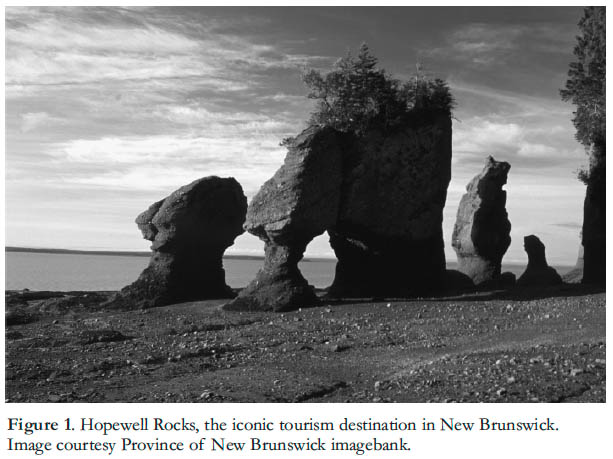
Display large image of Figure 1
4 Although all of these organizations incorporate aspects of geological heritage into their work, it has been the Department of Natural Resources and the New Brunswick Museum that have, until recently, been most involved with the province’s geological heritage. That is starting to change, partly as a result of the drafting of new heritage legislation and the recognition that fossils and landscapes should be included as part of our provincial heritage, and partly because of overlapping interests and synergies developed between departments with differing mandates. In addition, the small size of New Brunswick, geographically and politically, has much to do with the convergence of a small group of people interested in geoheritage.
WHAT IS GEOHERITAGE?
5 Geoheritage is a relatively new term that has various definitions (Donaldson 2008). The concept has even spawned a new journal (Geoheritage) from Springer that includes, within the spectrum of geoheritage, a range of topics including geodiversity, geosites, geoparks, stratotype conservation and management, scientific research, education, the promotion of the geosciences, materials, data, people important in the history of science, museums, collections, and all portable geoheritage. These many components of geoheritage enable a holistic view of what makes up the heritage of the geological sciences.
6 Heritage can be defined as the passing on of knowledge to our descendants, or as something acquired from a predecessor. In the case of geo-heritage the ‘something’ is knowledge of geology. But what is meant by knowledge of geology? It could be seen as the sum of geological information gathered over the years and published in scientific literature. It includes the training of students, mentoring, and public education. It is the accumulated data derived from geologic investigation, the specimen record of geologic research, and geodiversity (Gray 2004, 2008), including the outcrops and landscapes that preserve geologic information. It is also the history of the science of geology, including artifacts, built heritage and toponymy. This is a very broad range of subject matter to include within the geoheritage sphere, and it is not likely that any single system for documenting and preserving geoscience heritage can exist. Much of this role is assumed by university departments and government geological surveys, whose primary focus is the accumulation, analysis, and dissemination of geological knowledge. To make the subject more manageable, this paper will look at a subset of geological heritage in New Brunswick, and examine the resources available for recording the history of geology, for conserving geological sites, and for preserving documents, specimens, the history of geology, and associated artifacts and built heritage.
OUR HERITAGE RESOURCES
7 How well do we do as geoscientists in New Brunswick in preserving our geological heritage? What resources are available for understanding our geoheritage? Where do we stand in documenting our history; in conserving and preserving our geosites, documents, specimens, artifacts, and built heritage; and in advancing legislation to support these efforts?
Recording Our History
8 Geoscientists excel at writing histories of geology, both for professional and lay audiences. This writer’s bookshelf is a small sampling of this: The Meaning of Fossils by Martin Rudwick; Wonderful Life by Stephen Gould; The Role of Women in the History of Geology edited by Cynthia Burek and Bettie Higgs; Discovering Fossil Fishes by John Maisey; Charming the Bones by Ann Elliot; and The Map that Changed the World by Simon Winchester. There is no shortage of resources, and there are still great stories to tell. Recounting stories of past geologists and their discoveries is something that our profession has taken on with enthusiasm. Our profession understands that the effort demands a detailed understanding of prior work and the people involved; the collected works published by the GAC as Proud Heritage: People and Progress in Early Canadian Geoscience is proof of that (McQueen 2004).
9 Stories abound, but compiling the details and writing them down has been the task of relatively few in our profession. I remember that, as an undergraduate student, the early history of geology in Canada that this writer was taught centred on Sir William Logan, Sir William Dawson, and few others. Our history is only as good as the research and publications that document it, and our ability to disseminate that information. Fortunately, the last few decades have seen an increase in the research and documentation of New Brunswick stories, and as a result we now have a much richer and more accurate published history of geology in New Brunswick. New Brunswick has many great stories of people such as Loring Bailey (Young 2005), Robert Chalmers (Brookes 2008), Robert Foulis (Wright and Miller 1990), Abraham Gesner (Matthew 1897; Barkhouse 1980; Mitcham 1995; Brice 2002; Miller and Buhay 2007b), Fred Hartt (Matthew 1890; Brice 1994), George Matthew (Cassidy 1987; Miller 2003, 2005), William Matthew (Colbert 1992; Miller 1994), and James Robb (Bailey 1976), to name a few of the better known 19th century geologists (Fig. 2). Recent publications have assembled a broader view of the province’s geoscience history as expressed by past mineral exploration, mining and quarrying activities (Martin 1990, 2003).
Figure 2. The story of young Will Matthew discovering a giant trilobite has been told in a scientific paper, Will Matthew’s biography, and in “Fossil Hunter” an exhibition and children’s book by the New Brunswick Museum. Painting by J. Pennanen, New Brunswick Museum.Documents
10 Primary and secondary sources of geological information exist in New Brunswick’s archives and libraries. The Provincial Archives, the archives of the New Brunswick Museum, and the University of New Brunswick are principal sources of primary documents such as letters, field notebooks and maps. This is just a small part of the relevant archival material scattered in many institutions across North America and Europe. For example, correspondence from the Natural History Society of New Brunswick can be found at the National Archives of Canada, the Boston Museum of Science, and the Natural History Museum, London, to name a few. The University of New Brunswick, Mount Allison University, the New Brunswick Department of Natural Resources and the New Brunswick Museum all have geological libraries. Most, like the New Brunswick Museum Archives and Research Library (Fig. 3) have a history dating back to the beginning of geological exploration in the province (Miller and Buhay 2007c). However, there is a need for space in these institutions, which has led to a weeding of older materials from collections, and even the closure or downsizing of some geological libraries. The increasing access to electronic resources sometimes threatens collections of older works that are (in this writer’s experience) sometimes viewed as irrelevant. In our profession this is anything but true. Original descriptions of fossils or outcrops made 100 years or more ago can prove to be vital to current research. Furthermore, from the point of view of geoheritage, these are crucial resources for unravelling the scientific and cultural history of geology.
Figure 3. Bookplates in the New Brunswick Museum library collection trace the history of the geological library from the Saint John Mechanics’ Institute to the Natural History Society of New Brunswick to the New Brunswick Museum.
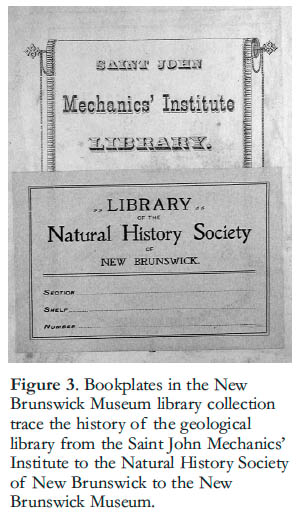
Display large image of Figure 3
11 Locally focused books like Gesner’s Dream (Martin 2003), and more broadly based works such as William Diller Matthew: Paleontologist (Colbert 1992) and Charles Doolittle Walcott (Yochelson 1998) rely on primary and secondary documentation. All three authors drew upon archival resources in the New Brunswick Museum to research their books. If we do not preserve our own stories, who will?
Type Sections
12 Outcrops, particularly stratigraphic type sections, are the ‘fundamental units’ of geological mapping and for understanding geology. Although we name the rock units according to international rules, there is little done to maintain the key sites and sections afterwards. Preservation and conservation of all type sections may be an impossible task; sections come and go as geological relationships are reworked. However, some stratotypes are more significant than others, and may possess a greater longevity than others. Even dismissed stratotypes may have significance as a subject of continued research. In New Brunswick, there is no system for protection of type sections. The New Brunswick Department of Natural Resources has put the provincial bedrock lexicon online, which does make the information more timely and accessible. Although the current Historic Sites Protection Act could be used to recognize and protect geological sites, it has not yet been applied for this purpose.
Specimens and Artifacts
13 Specimens are a significant heritage resource, and various systems exist for their preservation. Probably the most regulated systems are those that apply to palaeontology and mineralogy, with their tradition of depositing primary and secondary type specimens in museum collections (Fig. 4). Even here, of course, the system has some problems, because not every type specimen makes its way to a permanent collection. Some collections, most notably those at the national and provincial museum level, have strict protocols for accession, and equally important, de-accession, of specimens. University and private collections are more likely to last only as long as the custodian of the collection. For example, the Mount Allison University geology collection was dispersed following the phasing out of the department in the late 1990s. Private collections are often offered to our museum as they outgrow an individual’s ability to maintain them. On the other hand, the New Brunswick Museum Act and museum policies ensure the longevity of collections; hence, museums employ curators whose job it is to develop and maintain these collections. In New Brunswick, we have made an effort to rebuild the geological component of the provincial museum. The museum’s history can be traced to Gesner’s Museum (Miller and Buhay 2007b), which was primarily a geology museum and one of the first museums in Canada open to the public. Although the provincial museum has the mandate to be the provincial repository for natural science specimens collected in New Brunswick, not all specimens are sent to the museum, nor does the museum have the resources to keep everything. Priorities are aimed at maintaining all type specimens, and specimens of lasting research value.
Figure 4. Figured type specimen of fossil trackway Pseudobradypus sp. NBMG 14143 from the Grande Anse Formation. New Brunswick Museum collection.
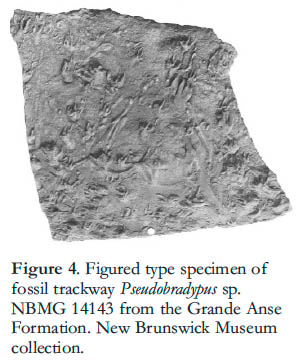
Display large image of Figure 4
14 The International Council of Museums [http://icom.museum/] defines a museum as a “permanent institution in the service of society and of its development, open to the public, which acquires, conserves, researches, communicates and exhibits the tangible and intangible heritage of humanity and its environment, for the purposes of education, study, and enjoyment”. The word museum is often used to refer to interpretation centres that are not involved in acquisition, conservation and research, but which instead focus on communicating and exhibiting. I would argue that museums are in a good position to maintain and promote geological heritage, in part because they are in the ‘heritage business’, as well having roles in public education and tourism. Most university and industry geoscientists probably do not have a heritage component to their job, nor do they, as their colleagues in museums do, have a direct tie to heritage departments of government.
15 In New Brunswick, the museum has tried to maintain an active role in geoheritage and developing regional expertise. On more than one occasion I have been asked by a geoscientist from a larger institution, “Do I not think we would be better served by concentrating collections in larger centres?” The discussion often concerns type specimens, and the argument is valid; larger institutions might be better able to care for specimens, although there are examples in which that is not true. The most compelling argument is that it would facilitate research by having many specimens in one place, thus making it easier and less expensive for researchers to view the material. However, I contend that, at least in New Brunswick’s case, minerals and fossils are a provincial responsibility, valued as heritage objects that tell the story of our region. I would further argue that, if the best specimens left the province, to be housed in a national or international institution, we would be left with little to develop regional expertise, employ our own geoscientists, and study regional geology. What would we exhibit to museum visitors, or use to inspire a new generation of scientists? To retain such material, a museum must behave like one, maintaining standards of collection, care and research. Strong regional museums employ more geoscientists across Canada than our single national natural history museum.
Databases
16 Electronic compilations of heritage information, such as virtual exhibitions and museum catalogues accessible via the internet, are becoming more common. Museum catalogues are accessible via the internet, and virtual exhibitions are becoming more common [www.nbm-mnb.ca]. In New Brunswick, the Department of Natural Resources has developed a tremendous resource for geoscience heritage by putting the bedrock lexicon online and creating other databases, including searchable databases concerning Mineral History, Fossils, Mineral Occurrences and Publications. The Mineral History Database, derived largely from transcribed newspaper records going back to the late 1700s, is a great example of how information can be made accessible [http://www.gnb.ca/0078/minerals/databases-e.aspx]. For anyone interested in the history of geology in New Brunswick, this is an invaluable resource. Previously, researchers were required to search through metres of microfilm, an impediment to research for many of us.
Legislation
17 In New Brunswick, legislation concerning geological matters is primarily dealt with by the Mining Act, which defines and regulates mining in the province, similar to other jurisdictions in Canada. Minerals and fossils are both discussed in the act, but the focus is understandably on minerals as a resource. Proposed changes to the current heritage legislation would bring the protection of fossils and fossil sites under the heritage umbrella; this will be cahieved by a new Heritage Conservation Act that was introduced in the Legislature in November 2009. Protection of landscapes as heritage sites is also under consideration as changes are made to heritage legislation. For geo-heritage, this means that unique glacial landscapes or areas of karst topography could be protected as representative of our geological heritage. Legislation regarding toponymy (place names) is also likely to be part of revised legislation. For those questioning the importance of place names to geoheritage, the reader might recall the fiasco over the renaming of Mt. Logan. An example of preserving geoheritage in place names from New Brunswick would be the ‘Geologists’ Range’ (Fig. 5). The naming of this series of low mountain peaks in northern New Brunswick was proposed by William Ganong on December 5th, 1899 to recognize the contribution to the province made by 19th century geologists (Ganong 1899, 1903). Other pieces of legislation pertain to geoheritage, at least peripherally, includes the Highway Act, the Bituminous Shale Act, the New Brunswick Museum Act, the Protected Natural Areas Act, the Clean Water Act and the Quarriable Substances Act. Finding ways to deal with geoheritage through legislation becomes complicated, and extends well beyond areas familiar to most geoscientists.
Figure 5. The Geologists Range in northern New Brunswick. Mountains were named by W.F. Ganong in 1903 to recognize the contributions of early geologists working in New Brunswick. From north to south; Mount Bailey, Mount Chalmers, Mount Ells, Mount Matthew and Mount Robb. Not shown is Mount Hartt to the south. National Topographic Series (NTS) 21 O/7, Nepisiguit Lakes (1:50 000). Surveys and Mapping Branch, Department of Energy Mines and Resources, Canada.GETTING INTO THE HERITAGE SYSTEM
18 If the resources are available to explore and develop the rich geo-science heritage information within a given jurisdiction, how can this important part of our society’s heritage be preserved and promoted? This writer’s experience is that the general public does not consider geoscience to be part of our collective heritage; it is not thought of as part of our history in the same manner as shipbuilding or politics, partly, of course, because most people are unfamiliar with the science of geology. Frameworks to recognize and conserve heritage are already in place in New Brunswick, which has a list of historic places that includes more than 1100 sites. However, only two of these are assigned to the list on the basis of their geological significance. The current heritage legislation does not deal with geology except that in the Historic Sites Protection Act, a place might be nominated as an historic site because of its geologic features. The Albert Mines site in Albert County [https://www.rhp-rlp.gnb.ca/] is described as a 324 hectare defunct mine site, with outcrops of albertite, visible ruins including mine-shafts (Fig. 6), tailings piles, manager’s house and a church. Nevertheless, its significant fossil record of Mississippian palaeoniscid fish was not included in its heritage description. The second geological feature on the New Brunswick list is ‘Glacier Rock’, a large erratic in a park in McAdam.
Figure 6. Remnants of the headframe foundation at the albertite mine, developed about 1870, at Albert Mines, New Brunswick.
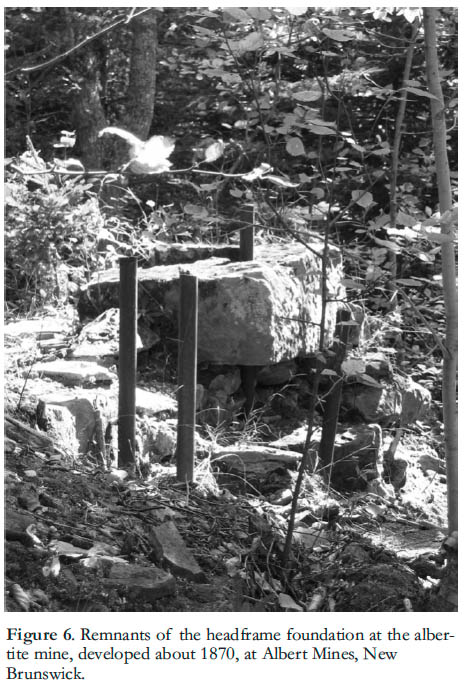
Display large image of Figure 6
19 New Brunswick participates in a federal government program called the Historic Places Initiative (HPI) [http://www.pc.gc.ca/docs/pc/rpts/rve-par/21/index_e.asp]. The Government of Canada launched the HPI in 2001 to set out a national strategy for providing the tools that Canadians need to participate in conserving and celebrating historic places “to improve the state of conservation in Canada and increase Canadians’ access to, and understanding of, their heritage by actively engaging them in its preservation.” Nationally, only one site on the list is recognized for its fossil content. In New Brunswick, our museum staff, working with the province’s Heritage Branch, has recently documented twelve sites that combine a significant fossil record and a history of scientific study, as a contribution to New Brunswick’s Register of Historic Places and ultimately the national HPI. The intent is to use the existing heritage framework to encompass geoscience heritage. It seems like a simple solution for the promotion of geoscience heritage, yet with over 1100 provincial listings and more than 9800 national heritage sites, only a handful are recognized as important for geoscientific reasons. This may simply be because there is no organization promoting geoheritage sites to the HPI. Nominations, and the research needed to document the significance of a given site, must come from the geoscience community. Perhaps our national Canadian Federation of Earth Sciences might be an appropriate lobby group for the profession, although compiling site information is probably a grassroots effort. Documentation must follow strict guidelines that include a statement of significance, geographic boundaries, and a list of “character-defining elements” that clearly identify what aspects of the site make it significant.
GEOHERITAGE OPPORTUNITIES IN NEW BRUNSWICK
20 Many opportunities exist for the development of geoheritage in both professional and public areas. Within our profession, maintaining support for institutions that preserve geoheritage (museums and archives) is critical, as is support for geoheritage research itself, because the long-term care of physical evidence encourages both geological research and public awareness of geology. Although we are not historians, as a profession we are reasonably adept at delving into the history of geology. Geology is a demanding discipline that has its own arcane language, and unlike many other fields, the concept of geologic time makes it difficult for outsiders to grasp. Therefore, public presentation of geoheritage depends on quality research.
21 In the public realm, we have had some success in making people aware of the importance of geology. Much of that has to do with informing society about natural hazards and the importance of mining to our lifestyle. We could perhaps do more to integrate the study of geology into the social and educational fabric, in addition to showing how it serves society. In New Brunswick we celebrate shipbuilding as a great achievement of our citizens and recognize the people and places that are part of that history. While achievements in geology are recognized, it does not have the same cachet as the ‘Golden Age of Sail’. However, there was a time when geoscience activity was seen as part of the intellectual and social community. On Friday, October 7, 1921, George Matthew was invited to a banquet held in his honour at the Union Club in Saint John. George Matthew, a customs agent, was leaving New Brunswick after a lifetime of service. The banquet attracted a Who’s Who of New Brunswick society; in attendance were Mayor Schofield of Saint John, The Honourable Walter Foster, Premier of New Brunswick and The Honourable William Pugsley, Lieutenant Governor of New Brunswick. They, and many others, were not there to honour George Matthew the customs agent, but rather to recognize Dr. Matthew’s achievements in science (Cassidy 1987), and his extraordinary career spanning six decades of geological exploration and research with the Natural History Society of New Brunswick. The newspaper reported the banquet as a “splendid testimonial … given by a representative gathering of men, distinguished in intellectual and business spheres of the province” (Daily Telegraph, Saturday, 8 October, 1921, p. 5). My experience in Saint John suggests that few people outside the specialist community of geoscientists know about the geological work that was conducted here. Since 1921, when Matthew was honoured by his peers for the attention he had brought to the city and province, the awareness of that aspect of the community has all but disappeared. Popular history has focused on Saint John being Canada’s oldest incorporated city, and on the city’s heritage buildings, labour history, and shipbuilding history.
22 There are means to change the perception of geology, and there is ample opportunity for improved geological interpretation of existing tourism attractions. Top tourist attractions like the Hopewell Rocks, the Reversing Falls, Sugarloaf Mountain (Fig. 7), and the Bay of Fundy are all geological features. Unfortunately, all could benefit from additional efforts to explain their geological significance. Of all these sites, interpretive information at the Hopewell Rocks offers the best explanation for a specific geological feature. Mining tourism is a small but developing niche market, and old mine sites could be developed to explain our industrial heritage. This province also had a thriving building-stone industry during the 1800s to mid-1900s; many of the buildings in Saint John (Fig. 8), Fredericton, Miramichi and elsewhere (e.g. New York City) are constructed from local stone (Martin 1990; Miller and Hughes 2009). With adequate protection in place, fossil sites could be promoted as part of our geoheritage. New Brunswick’s rich fossil history includes the first Precambrian fossil to be described in the scientific literature (Miller 2003), the Pennsylvanian ‘Fern Ledges’ (the site of a heated debate over the age of the rocks; Falcon-Lang and Miller 2007), and classic Devonian plant, vertebrate, and invertebrate localities along Chaleur Bay/Baie des Chaleurs (Clarke 1909; Gensel and Andrews 1984; Miller et al. 2003; Miller 2007). A Maritimes geotourism product could be just around the corner. Nova Scotia is now home to a UNESCO World Heritage Site at Jog-gins, and nearby at Parrsboro is the site of the oldest dinosaurs in Canada. The UNESCO World Heritage Site at Miguasha, Québec is a short distance from additional interesting geological sites at Dalhousie and Campbellton in northern New Brunswick.
Figure 7. The Devonian volcanic neck known as ‘Sugarloaf’ at Campbellton, New Brunswick, is part of a provincial park.Figure 8. Sandstone from the Caledonia Quarry in eastern New Brunswick was used to build the ‘Old Post Office’ in Saint John, ca. 1877-80.CASE STUDY: GEOPARK PROJECT
23 Geotourism, based on the observation and understanding of geology, is a growing part of the tourism market (Dowling and Newsome 2006). While geotourism is not new, the recent development of the European Geoparks Network and the UNESCO-sponsored Global Geoparks Network are providing models for engaging the public that link sustainable economic development with the preservation, interpretation, and appreciation of geology. We think of geotourism destinations as sites with spectacular landscapes and obvious interpretive and geological impact, but there are other opportunities to incorporate less obvious geological stories into the realms of tourism and public education. In the Saint John region, a community group has been exploring the development of a geopark that would incorporate a billion years of the geologic record and more than 170 years of geoscience study (Miller 2008a, b). In November 2009, an application was submitted to UNESCO and the Global Geoparks Network in a bid to create the ‘Stonehammer Geopark’ in southern New Brunswick. Interest has come, in part, from the tourism industry, which seeks to enhance a product that includes exploitation of cultural and natural attractions in a market that strives to provide unique, value-added experiences for visitors (Fig. 9). In Saint John, boat tours of the Reversing Falls have added the geological story of the gorge to their traditional interpretation of the tides. Kayak tour guides are seeking information about geology to enhance their stories of the natural and cultural landscape. Trail designers are looking for information to develop interpretive signs along walkways (Fig. 10). Tour operators working the cruise-ship market have considered tours of geological sites for ship passengers. Saint John offers the geology, but perhaps more important it offers the history of science and exploration. Few cities can compare to the Saint John region in terms of the geological complexity and diversity seen here. Neither can most cities claim such a long history of geoscience investigation, dating back more than 170 years to the work of Abraham Gesner. Professional geo-scientists continue to visit the area on field trips or while engaged in current research, continuing a tradition of exploration that includes such notable geologists as Sir Charles Lyell and Charles Walcott.
Figure 9. New Brunswick Museum public tour of Pennsylvanian rocks near Gardner Creek, New Brunswick.
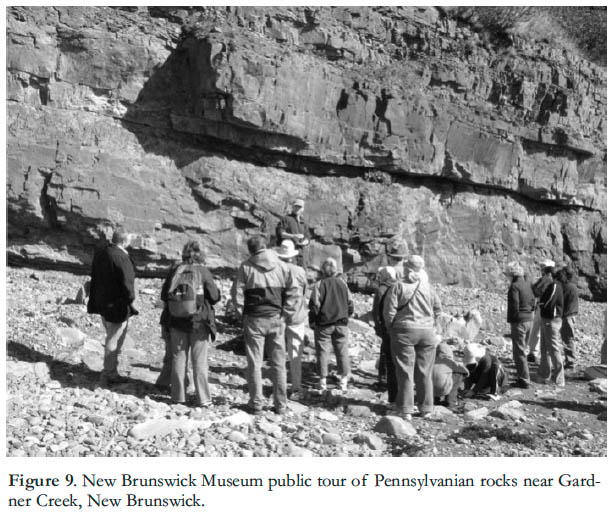
Display large image of Figure 9
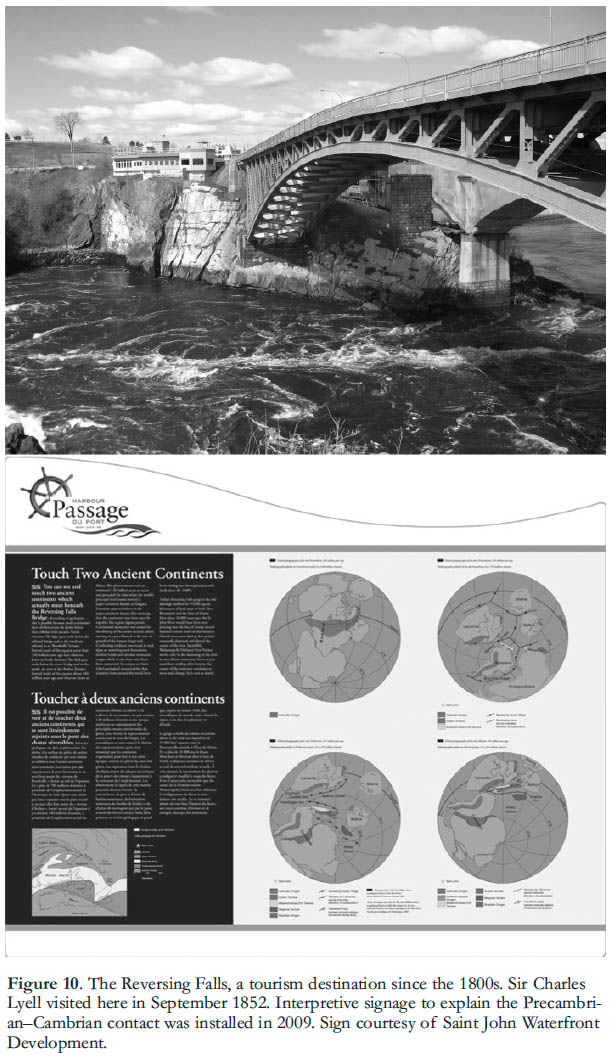
Display large image of Figure 10
24 The Saint John region has a long and significant history of geological exploration; coastlines, parks and public lands where the geological story of the region can still be seen in rock outcrops; and a tourism industry already engaged in geotourism. A geopark would tie together dozens of sites to introduce visitors to almost a billion years of earth history, allowing them to follow the history of geo-science thought from the early 1800s to today. All of this, however, depends on the geoscience community’s ability to translate a relatively hidden past into a vibrant part of our social history that can be readily appreciated by the public. Ultimately, presenting geoheritage as an interesting and significant part of our heritage relies on the resources required to research, document, promote and protect it.
ACKKNOWLEDGEMENTS
The author thanks Reg Wilson for suggesting a series of papers following the Geoheritage Symposium at the 2008 GAC–MAC conference in Québec City and for his work to improve this manuscript. Thanks also to Al Donaldson, the series editor, for his patience and assistance. Thanks to Les Fyffe and the New Brunswick Department of Natural Resources for their financial support to attend the conference. RFM gratefully acknowledges receipt of a SSHRC–CURA grant (833-2003-1015) and the support of the New Brunswick Environmental Trust Fund.REFERENCES
Bailey, A., 1976, Robb, James, in Brown, G.W., Hayne, D.M. and Halpenny, F.G. eds., Dictionary of Canadian Biography, Volume IX, 1861-1870: University of Toronto Press, Toronto, p. 665-666.
Barkhouse, J., 1980, Abraham Gesner: Fitzhenry and Whiteside, Don Mills, Ontario, 64 p.
Brice, W.R., 1994, Charles Frederic Hartt (1840-1878): The early years: Earth Sciences History, v. 13, p. 160-167.
Brice, W.R., 2002, Abraham Gesner (1797-1864), A Petroleum Pioneer: Oil-Industry History, v. 3, p. 72-80.
Brookes, I., 2008, Robert J. Chalmers: Pioneer surficial geologist: Geoscience Canada, v. 35, p. 127-136.
Cassidy, G.J., 1987, George Frederic Matthew: Invertebrate paleontologist: Geoscience Canada, v. 15, p. 157-163.
Clarke, J.M. 1909, Early Devonic History of New York and Eastern North America: Memoirs of the New York State Museum, v. 9, no. 2, 250 p.
Colbert, E.H., 1992, William Diller Matthew, Paleontologist: The Splendid Drama Observed: Columbia University Press, New York, 275 p.
Donaldson, J.A., 2008, Geoheritage: Geo-science Canada, v. 35, p. 49-50.
Dowling, R., and Newsome, D., 2006, Geotourism: Elsevier, Oxford, UK, 260 p.
Falcon-Lang, H.J., and Miller, R.F., 2007, Marie Stopes and the Fern Ledges of Saint John, New Brunswick, in Burek, C.V., and Higgs, B. eds., The Role of Women in the History of Geology: Geological Society, London, Special Publication 281, p. 227-245.
Ganong, W.F., 1899, Notes on the natural history and physiography of New Brunswick (30. Proposal for a nomenclature of unnamed New Brunswick hills and mountains, p. 248-256): Natural History Society of New Brunswick, Bulletin No.18, p. 227-257.
Ganong, W.F., 1903, Notes on the natural history and physiography of New Brunswick (68. The nomenclature and origin of the Geologists Range, p. 87-88): Natural History Society of New Brunswick, Bulletin No.18, p. 227-257.
Gensel, P.G. and Andrews, H.N., 1984, Plant Life in the Devonian: Praeger, New York, 380 p.
Gray, M., 2004, Geodiversity: Valuing and Conserving Abiotic Nature: John Wiley and Sons, Ltd, UK, 434 p.
Gray, M., 2008, Geodiversity: A new paradigm for valuing and conserving geo-heritage: Geoscience Canada, v. 35, p. 51-59.
Martin, G.L., 1990, For love of stone: Volume I: The story of New Brunswick’s building stone industry: Volume II: An overview of stone buildings in New Brunswick: New Brunswick Department of Natural Resources and Energy, Mineral Resources Division, Miscellaneous Reports 8, 9.
Martin, G.L., 2003, Gesner’s Dream: The Trials and Triumphs of Early Mining in New Brunswick: Canadian Institute of Mining, Metallurgy and Petroleum, New Brunswick Branch, Fredericton, New Brunswick, 328 p.
Matthew, G.F., 1890, Charles Frederick Hartt: Natural History Society of New Brunswick, Bulletin No. 9, p. 1-24.
Matthew, G.F., 1897, Abraham Gesner: A review of his scientific work: Natural History Society of New Brunswick, Bulletin No. 15, p. 3-48.
McQueen, R.W., 2004, Proud Heritage: People and progress in early Canadian geoscience: Geoscience Canada Reprint Series 8, Geological Association of Canada, St. John’s, Newfoundland, 217 p.
Miller, R.F., 1994, Palaeontologist William Diller Matthew: Early years in New Brunswick and the story of the giant trilobite: Geoscience Canada, v. 20, p. 153-157.
Miller, R.F., 2003, George Frederic Matthew’s contribution to Precambian paleobiology: Geoscience Canada, v. 30, p. 1-8.
Miller, R.F., 2005, George Frederic Matthew, in Cook, R., ed., Dictionary of Canadian Biography, Volume XV, 1921-1930: University of Toronto Press, Toronto, p. 721-722.
Miller, R.F., 2007, Nineteenth century collections of Pterygotus anglicus Agassiz (Chelicerata; Eurypterida) from the Campbellton Formation, New Brunswick, Canada: Atlantic Geology, v. 43, p. 197-209.
Miller, R.F., 2008a, Geotourism in Saint John, New Brunswick: Atlantic Geo-science Society 34th Colloquium and Annual Meeting, Program and Abstracts, Dartmouth, Nova Scotia, February 1-2, 2008, Atlantic Geology, v. 44, p. 27.
Miller, R.F., 2008b, A concept for a “Saint John-Fundy region” Geopark in eastern Canada, in Escher, H., Hartling, J.W., Kluttig, T., Meuser, H. and Mueller, K. eds., Proceedings of the 3rd International UNESCO Conference on Geoparks June 2008, Osnabruck, Germany, p. 81-82.
Miller, R.F., and Buhay, D.N., 1988, The Steinhammer Club: Geology and a foundation for a natural history society in New Brunswick: Geoscience Canada, v. 15, p. 221-226.
Miller, R.F., Cloutier, R. and Turner, S., 2003, The oldest chondrichthyan from the Early Devonian period: Nature, v. 425, p. 501-504.
Miller, R.F., and Buhay, D.N., 2007a, Sir Charles Lyell’s travels in New Brunswick, Canada, in 1852: Atlantic Geology, v. 43, p. 36–44.
Miller, R.F., and Buhay, D.N., 2007b, Gesner’s Museum of Natural History, an Early Canadian Geological Collection: Geoscience Canada, v. 34, p. 37–48.
Miller, R.F., and Buhay, D.N., 2007c, The geological library of the Natural History Society of New Brunswick: Supporting early scientific research in the Maritimes region: Atlantic Geoscience Society 33rd Colloquium and Annual Meeting, Program and Abstracts, Moncton, New Brunswick, February 2-3, 2007, Atlantic Geology v. 43, p. 18.
Miller, R.F., and Hughes, G.K., 2009, Rebuilt in Stone: Geology and the Stone Buildings of Saint John, New Brunswick: New Brunswick Museum, Saint John, 32 p.
Mitcham, A., 1995, Prophet of the Wilderness: Lancelot Press Ltd, Hantsport, Nova Scotia, 208 p.
Wright, H.E., and Miller, R.F., 1990, Robert Foulis (1796-1866): New Brunswick inventor, entrepreneur and geologist: Geoscience Canada, v. 17, p. 101–104.
Yochelson, E., 1998, Charles Doolittle Walcott, Paleontologist: Kent State University Press, Kent, Ohio, 510 p.
Young, C. M., 2005, Bailey, Loring Woart, in Cook, R., ed., Dictionary of Canadian Biography, Volume XV, 1921-1930: University of Toronto Press, Toronto, p. 43-45.
